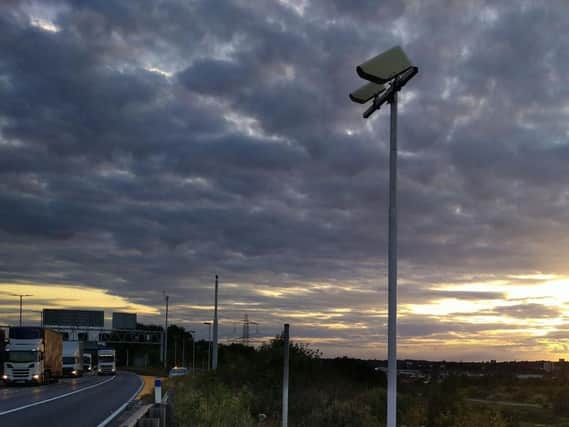New roadside weather station on A1 near Peterborough will help keep traffic moving


The station, located at Sibson, is one of several placed on main routes across the country.
The weather stations provide vital information to the Highways England teams who are in charge of keeping strategic roads safe and reliable for drivers who need to make essential journeys.
Advertisement
Hide AdAdvertisement
Hide AdThe equipment gives live updates on conditions to help maintenance teams decide when to send up to 535 gritters out onto the network, as well as understanding the risks of surface water or high winds causing disruption.
The weather stations also help the Met Office provide precise forecasting information for England’s biggest roads and more than 50 have been replaced at key locations since 2015. Another 12 are being installed this winter, including at Sibson.
Katy Little, Highways England’s winter services project manager, said: “We’ve been updating our weather stations with the latest technology to make sure the data we’re getting is as accurate as possible, and to help us make decisions which will keep the roads moving in the winter months.
“The updates from our weather stations also feed into the Met Office’s national system, which means our roadside sensors are helping to produce the weather forecast you check at the start of each day.
Advertisement
Hide AdAdvertisement
Hide Ad“It’s important that drivers who must travel in wintery conditions leave extra time for their journeys and make sure they and their vehicle are prepared. Drivers should carry out vehicle checks and pack essential items such as warm clothes and an ice scraper before setting out.
“Drivers are reminded to check weather forecasts before setting out and to take care when travelling around gritters.”
The weather stations use sensors mounted to metal poles at the side of the road to provide statistics on air temperature, precipitation, humidity, wind speed and visibility. The poles are fitted with hinges which means they can be easily lowered for maintenance without needing to close the road.
Sensors in the road surface and 30 centimetres underground also provide temperature readings as well as accurately measuring the depth of water or snow on the carriageway. And two CCTV cameras provide live images of the road in both directions.
Advertisement
Hide AdAdvertisement
Hide AdThe information from weather stations helps Highways England plan for all eventualities. This winter the lower traffic levels experienced due to national lockdown restrictions mean gritting services are being adapted to keep drivers safe, with additional salt being spread.
Salt lowers the freezing point of moisture on the road surface, so it must be colder before it turns to ice. Dry salt has to draw in moisture to form a salt solution (or brine) to become really effective and, to help accelerate this process, Highways England’s gritters often spread concentrated brine onto dry salt as it is spread. Traffic makes this more effective as it further crushes and spreads the salt.
Abi Oakes, Senior Account Manager, Transport, at the Met Office, said: “Good quality, reliable weather observations are the foundation of any forecast. They allow weather forecast models to reflect the on-the-ground situation, helping to give an accurate starting point for the forecasting process. They also allow us to verify our forecasts and to keep ahead of any changes.”
Drivers are being advised to stick to the main roads where they can during snowy weather, and only travel if essential. They should also have snow kits in their vehicle, including an ice scraper and de-icer, warm clothes and blankets, and sunglasses to cope with the low winter sun.
Advertisement
Hide AdAdvertisement
Hide AdWhen snow is forecast, drivers who must make essential journeys are urged to give a wide berth to the fleet of gritters helping to keep Highways England’s roads moving.
Drivers should take extra care near gritters, leave a safe distance, overtake gritters carefully when it is safe to do so and at a reduced speed, and never use the hard shoulder illegally.
Gritters usually travel at 40-50 mph in the middle lane when they are spreading salt on a three-lane motorway, treating the lane they are in and one lane on either side. On motorways with more than three lanes they can be found in lanes 1 2 or 3 when salting.
Drivers should take extra care when snow clearance is underway. When ploughing, gritters may travel below 30mph. Drivers should not overtake gritters with snowploughs unless the lane they intend to use has been cleared. For lorries, staying in lane one is usually the best option, keeping a safe distance from the gritter ahead.